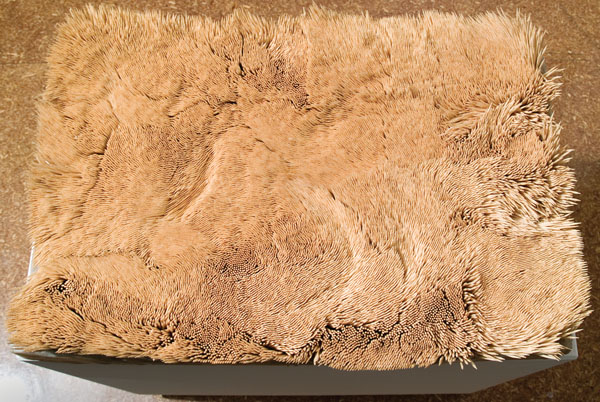
The catalogue essay by Andy Ewing for Territorial claims that the Australian Capital Territory (ACT) and the Northern Territory (NT) 'suffer a sense of isolation and alienation that is both physical and psychological.' Territorial it suggests, will 'investigate the mind-sets of internal territory, dark territory, peripheral territory and new territory&'. Unfortunately this hypothesis is so broad that it is meaningless. Territorial becomes a curatorial cliché, a failed attempt to group together a highly divergent selection of artists. After all, these artists work in dramatically different contexts and environments and are only united by a general sense that they operate beyond Sydney and Melbourne.
Worse, with the exception of Catriona Stanton's work, the NT artworks included in Territorial are not 'new'. Gary Lee's Mei Kimm and Minnie (2006) Shannon and Billiamook are a case in point. Fortunately, the high quality of works such as Mei Kimm and Minnie allow for a second viewing. In this work, Lee juxtaposes a digital photograph of his niece against a photograph of Minnie, his great great grandmother. Echoes resonate between the photographs of women from these two distinctive generations. Frank Gohier's included paintings have also enjoyed previous national exposure. Gohier creates his own language of signifiers from the recurring symbols of crossed-out words, dollar signs, historical photographs of chained Aboriginal people, comic language and imagery. The cross references and interplay between these repeated symbols in each painting builds up layer upon layer of resonance and meaning. Catriona Stanton's work comes closest to exploring the concept of territory. Stanton bypasses the use of literal imagery of politics, power and identity by taking a more 'poetic' approach. Her beautifully crafted toothpick fields (2006) are like carved out sections of landscape, placed carefully upon gallery plinths. These seductive works look like soft fur, inviting tactile engagement. But upon touch, one experiences a different reality of sharp, jagged spikes evoking images of a hostile environment.
The work of the ACT artists investigates the military/totalitarian 'Territorial' space of Australia under a Howard Government. Bernie Slater's We Know Who We Are (2006) is like the propaganda it criticizes: what you see is what you get. It ironically presents John Howard as the totalitarian leader: a Mao Ze Dong standing against a Chinese flag.
Australia Rising #1 by Raquel Ormella draws upon the chirpy 'Celebration of a Nation' logo (and accompanying song) that formed a central part of the 'official' bicentenary celebrations. Its stitched lettering made out of the green and gold material against the backdrop of an Australian flag highlights the gap between Government generated nationalist sentiment and the reality of the Government's social policy. After almost twenty years, it seems, there is little to celebrate – and the vision has become quite literally, frayed! Finally, Silvia Vélez Disruptive Identities 2007 features Camouflage pattern ID cards with images of Australian politicians superimposed over the top of them, all presented in plastic ID card holders.
I would like to describe Territorial as a fantastic exhibition that showcases the talent of contemporary artists in the NT and ACT at Darwin's innovative, cutting-edge art space: 24 Hr Art. But this is not the case. There are some excellent individual works within the show; particularly by the NT artists but the Darwin public is already familiar with most of the NT works selected. At issue here is the role that 24 Hr Art plays within Darwin's small contemporary art scene. Ideally, a dialogue between local, national and international artists (particularly in South-East Asia and China) requires the fostering of local, emerging, innovative talent. Territorial features a selection of older work by Darwin's more established contemporary artists juxtaposed with mediocre work from the ACT. Overall, it is a rather disappointing exhibition that fails to 'explore new territory.'












